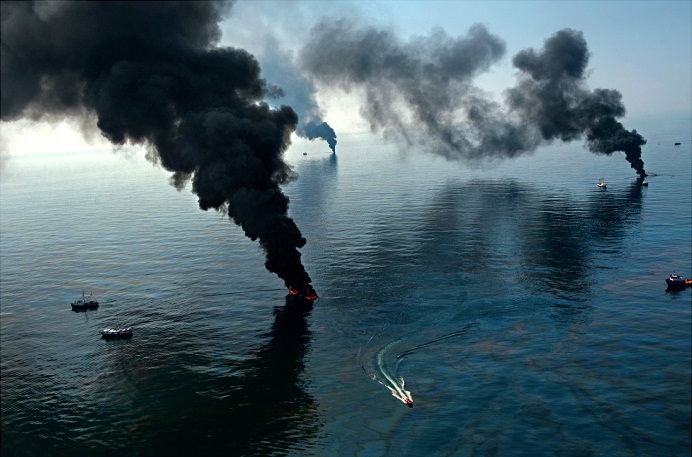
Chapter 24. Chapter 24: Petroleum
What unconventional sources of petroleum exist?

Guiding Question 24.5
What unconventional sources of petroleum exist? What are the benefits of using them? The costs?
Why You Should Care
Petroleum is produced by different combinations of organisms under different amounts of pressure. Therefore, different types of petroleum have different amounts of energy and different levels of EROEI (Chapter 19). Even so, crude oil is the main type of petroleum used today.
As petroleum has become more expensive, the costs of less desirable forms of petroleum become more attractive and their development ramps up. Today, we can also process petroleum from less dense (tar sands) or more solid (oil shale) forms. Tar sands and oil shales are found all over the world and are attractive because they can increase energy security for the nations in which the deposits are found. However, the process of separating the petroleum from the sands or squeezing the shales to release petroleum requires more energy and creates more waste than conventional petroleum.
Another drawback is that neither of these less-conventional forms of petroleum are as cheap or as energy-efficient, and all of them have environmental disadvantages. As long as we depend on petroleum, these reserves will be exploited as petroleum substitutes.
Test Your Vocabulary
Choose the correct term for each of the following definitions:
| Term | Definition |
|---|---|
| Recoverable oil that exists in rock, sand, or clay but whose extraction is economically and environmentally costly. | |
| Compressed sedimentary rocks that contain kerogen, an organic compound that is released as an oil-like liquid when the rock is heated. | |
| A heavy, black oil known as crude bitumen that is trapped in sticky, dense conglomerations of sand or clay. It can be mined and processed to produce a substitute for petroleum. |
1.
Oil shale differs from oil sands in what way?
| A. |
| B. |
| C. |
| D. |
2.
Tar sands do not produce:
| A. |
| B. |
| C. |
| D. |
3.
Why are tar sands and oil shale considered unconventional oil reserves?
| A. |
| B. |
| C. |
| D. |
4.
Energy return on energy invested (EROEI) for tar sands and oil shale are about one-quarter of the EROEI for petroleum and one-half the value for natural gas. Why is that?
| A. |
| B. |
| C. |
| D. |
5.
Thought Question: Given that tar sands and oil shales are more expensive than conventional petroleum, what factors would make them attractive choices for exploration?
Short-Answer Questions
Every four years, the United States holds a presidential election, and for the past 40 years, energy independence and energy security have become a popular theme for both political parties’ platforms. As peak oil and market pressures continue to drive prices up with little chance they will return to the historically low prices of the 1990s, proposals are advanced for new sources of conventional and unconventional petroleum.
Imagine that you were elected President of the United States and that one of your highest priorities was energy independence and energy security for increasing petroleum needs. Your goal is to offset recent increases in petroleum demand, provide long-term energy security, and potentially keep energy prices down. Your energy advisors list the following choices for you (they are listed with petroleum barrel equivalents):
A. Drill oil shale to replace conventionally drilled petroleum. This must be piped from predominantly Canadian shale deposits to the United States (1.3 billion barrels equivalent).
B. Drill natural gas using fracking-style methods in Western and Northeastern states (0.8 billion barrels equivalent).
C. Drill tar sands in Canada to replace conventionally drilled petroleum (0.5 billion barrels equivalent).
D. Increase conventional natural-gas drilling in the Gulf of Mexico and the Midwest (0.9 billion barrels equivalent).
E. Promote energy efficiency with tax rebates, grants, and subsidies to manufacturers (to produce more efficient models) and consumers (to buy more efficient models) (0.4 billion barrels equivalent).
Our country needs to offset 1.2 billion barrels of petroleum in this program. These projects would have approximately the same cost to the government (subsidies, regulation and oversight, tax revenues).
1) What combination of choices would have the cheapest cost (compared to current costs of production)?
2) What combination of choices produces the highest EROEI?
3) What combination of choices produces the least greenhouse gases?
4) Is there any combination of choices that would please most people?
2) E and either B or D. Unconventional reserves have low EROEI, so A and C are out. E has the highest potential EROEI, followed by D and then B. However, both B or D are lower than conventional petroleum extraction of current reserves.
3) D and E. E has the lowest greenhouse-gas production because they decrease gas production. D and B are popular, especially in the states where they would take place (Midwestern, Gulf, and Northeastern states). A and C have the potential to create the most gases since they yield the lowest amount of energy per volume of mined rock.
4) Politics are difficult to predict outside of the moment, but in general, conservation proposals are not very popular. Newer solutions are usually more popular, so any combination that included A or C would get publicity and more interest. B and D are well known and probably would come in a close second.
Activity results are being submitted...